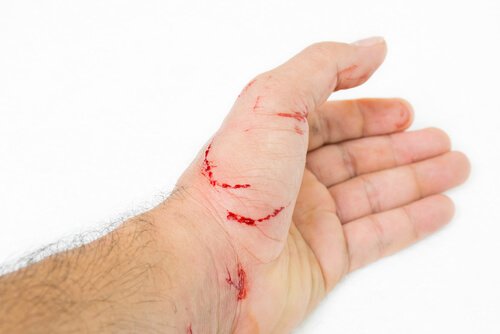What Is Cat Scratch Disease?

Felines extend their retractable claws and can easily hurt us, whether in self-defense or while playing. Some people can even get an illness from this, known as cat scratch disease. Learn more about it in this article.
What is cat scratch disease?
Its scientific name is bartonellosis, and it’s a rather uncommon infectious disease caused by a bacterium that belongs to the Bartonella genus (especially Bartonella henselae). It’s important to keep in mind that if a cat is infected with this microorganism, it won’t have any symptoms. Also, the cats that live in the same house may pass on this infection to each other.
Cat scratch disease is usually more common in autumn and winter. It’s a benign disease that will heal naturally after a few days (it usually doesn’t require any specific treatment).
The disease is more common in children, since they tend to be a bit rougher when they play with their pets. It’s also due to their skin being thinner and their immune system still developing.
Scientists discovered it in 1889, but they started to study it in more depth in the 1950s. According to research, small cats carry the infectious agent in their blood after being bitten by fleas or coming into contact with an infected cat’s stools.

The Bartonella henselae bacteria is most commonly transmitted from felines to people when they scratch them and open a wound. They can also spread it by biting humans. The microorganisms can be present in both their claws and their mouth.
Another way to get infected is by coming into contact with the fleas that are living on the cat’s skin, especially if they bite us. Also, there are cases of people who have got infected after a cat licks an open wound or cut, or the mucous membranes of their nose and eyes.
What are the symptoms of cat scratch disease?
The main signs of infection will show up where the cat scratched the skin; a lump or blister will appear there. Also, the secondary symptoms include pain and swelling in the lymph nodes (regional lymphadenopathy). In some cases, the person may have a fever, abdominal pain, chills, headache or back pain.
In the majority of cases, the infected wound will heal within a few days. However, you should keep in mind that lymphadenopathy may last for more than a month. It could also lead to severe complications for patients with immune problems.
There are certain tests that can detect cat scratch disease. For example, there’s a physical examination that will show if there’s an enlarged spleen, or, alternatively, you can do a lymph node biopsy.

Once the doctor has diagnosed you with cat scratch disease, they may not prescribe any medication. This is because there isn’t a specific drug for this disease and, also, because the human body’s antibodies can usually heal it by themselves.
However, if a child comes to the doctor’s with a very inflamed or infected area, the doctor will probably prescribe him azithromycin or doxycycline.
How to prevent cat scratch disease
Of course, prevention is very important to avoid catching any disease that our pets or stray animals may carry. Some tips to reduce the possibility of contracting this disease as much as possible are:
- Wash your hands with warm water and soap after playing with an animal.
- If a cat bites or scratches you, disinfect the area with soap or a product made specifically to treat the area.
- Play with animals gently to avoid bites or scratches.
- Don’t let animals lick your wounds, scars, mouth, eyes or nose.
- Use an anti-flea product—a pill, dropper, or collar—to reduce the spread of these disease-transmitting parasites.
- Don’t touch street cats to avoid scratches and bites.
- Clean your pet’s items well (toys, litter box, bed, or bowl).
Although cat scratch disease isn’t serious, you should still be careful not to let your pet hurt you. This will help you both avoid any undesirable consequences.
All cited sources were thoroughly reviewed by our team to ensure their quality, reliability, currency, and validity. The bibliography of this article was considered reliable and of academic or scientific accuracy.
Rodríguez-Rodríguez, M., Rodríguez-Rosell, M. V., Blanco-Costa, M. I., & Rodríguez-Asensio, J. (2017). Enfermedad por arañazo de gato. Presentación de varios casos clínicos. Atencion Primaria. https://doi.org/10.1016/j.aprim.2016.02.010